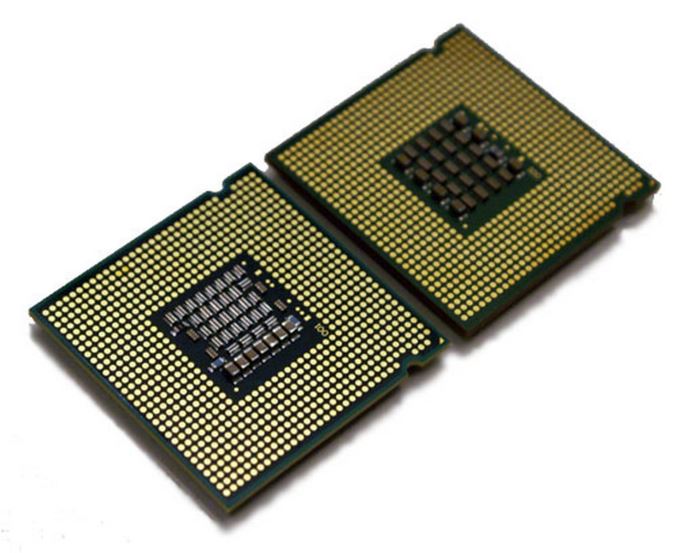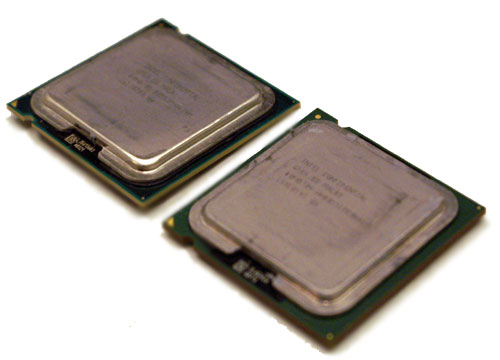Ten Year Anniversary of Core 2 Duo and Conroe: Moore’s Law is Dead, Long Live Moore’s Law
by Ian Cutress on July 27, 2016 10:30 AM EST- Posted in
- CPUs
- Intel
- Core 2 Duo
- Conroe
- ITRS
- Nostalgia
- Time To Upgrade

Today marks a full 10 years since the first Core 2 Duo processors, and hence Intel’s 64-bit Core microarchitecture, were made officially available at retail. These included a number of popular dual-core processor parts, including the seemingly ubiquitous E6400 and the Core 2 Extreme X6800. These were built on Intel’s 65nm process, and marked a turning point in the desktop processor ecosystem. To quote Anand in our launch review: ‘you’re looking at the most impressive piece of silicon the world has ever seen’.
Ten Year Anniversary of Core 2 Duo and Conroe
As part of this piece we will also look at some of the predictions for the future, from the latest (and possibly last) International Technology Roadmap for Semiconductors report, which predicts the stalling of smaller silicon manufacturing nodes over the next 10-15 years.
The first part of this article borrows heavily from Johan’s original look into the Intel Core microarchitecture back in 2006. It’s an awesome read.
Back When I Were A Lad
For a number of our readers, the launch of Conroe was a vast change in the processing landscape. The family of Netburst, Northwood and Prescott processors, in the form of Pentium D and Pentium 4, showed that pursuing the frequency race pushed the silicon far outside its efficiency zone and left a hot, power hungry mess in its wake. It didn’t even come with a muscular V8 sound, and AMD’s Athlon 64 X2 line had taken both the performance and efficiency crown.

Core 2 Duo (left) vs Pentium D (right)
From the perspective of Intel, it had to incorporate a significant paradigm shift in the way it approached the core microarchitecture – no more long pipelines to bump up clock rates to start. The Core microarchitecture design was marketed as a blend of Pentium Pro and Pentium M techniques, as well as the Netburst architecture, however as Johan pointed out at the time, it is significantly Pentium M and it is very hard to find anything Netburst in there. It wasn’t as simple as ‘adding a few functional units or decoders on Yonah and calling it a day’, almost 80% of the architecture and circuit design had to be redone.
As part of this piece, we’re going to take another look at the original architecture improvements of the Core microarchitecture design and some of our old performance metrics from a decade ago.
27th July 2006: Core 2 Launch Day
Ten years ago, Intel launched the following five processors:
| CPU | Clock Speed | L2 Cache |
| Intel Core 2 Extreme X6800 | 2.93GHz | 4MB |
| Intel Core 2 Duo E6700 | 2.66GHz | 4MB |
| Intel Core 2 Duo E6600 | 2.40GHz | 4MB |
| Intel Core 2 Duo E6400 | 2.13GHz | 2MB |
| Intel Core 2 Duo E6300 | 1.86GHz | 2MB |
The X6800 sits at the top with a higher clock speed with a higher supported FSB-to-core ration than previous Intel processors. The Core 2 processors all came from a 143mm2 die, compared the 162mm2 of Pentium D, and they both seem tiny by comparison to the large die sizes we see 2016 for things like the P100. These were chips without integrated graphics either. The introduction of Core 2 pushed the prices of the Pentium D processors down, to give this interesting table:
| CPU | Clock Speed | L2 Cache | Price |
| Intel Core 2 Extreme X6800 | 2.93GHz | 4MB | $999 |
| Intel Core 2 Duo E6700 | 2.66GHz | 4MB | $530 |
| Intel Core 2 Duo E6600 | 2.40GHz | 4MB | $316 |
| Intel Core 2 Duo E6400 | 2.13GHz | 2MB | $224 |
| Intel Core 2 Duo E6300 | 1.86GHz | 2MB | $183 |
| Intel Pentium D 945 | 3.40GHz | 2MBx2 | $163 |
| Intel Pentium D 915 | 2.80GHz | 2MBx2 | $133 |
| Intel Pentium D 820 | 2.80GHz | 1MBx2 | $113 |
| Intel Pentium D 805 | 2.66GHz | 1MBx2 | $93 |
Comparing this to recent Intel processors, and the X8600 matches the list price of the Core i7-5960X (an 8-core part), whereas the popular Core 2 Duo E6400 at $224 at the same price as the Core i5-6600.
A few years ago, I salvaged a super old computer of mine with an E6400 and took it for a spin for a pipeline piece entitled ‘Dragging Core 2 Duo into 2013’. We know that a number of users today are still using the old platform as their day to day machine, and given that it is now celebrating its 10th birthday, it is interesting that anyone wanting to play around with the old hardware can get a motherboard, memory and CPU from eBay for $50-70.
My crusty C2D Setup from 2013











158 Comments
View All Comments
fanofanand - Thursday, July 28, 2016 - link
Ian, your reviews are always too notch. You have incredible knowledge, and your understanding of both CPU and memory architecture etc is unparalleled in journalism. Ignore the trolls, this was a fantastic article.extide - Wednesday, July 27, 2016 - link
Different editors for different content. Honestly I thought this was a great piece. I think this site is not quite up to what it was back then, just go read the articles for Fermi, or when Bulldozer released and stuff, much more deep dives into the architecture. I realize that Intel and the other manufacturers may not always be willing to release much info, and they seem to release less these days but I don't know -- the site feels different.Honestly, and I am pretty forgiving, being as late as this site has on the recent GPU reviews is pretty inexcusable. Although, that is obviously nothing to do with Ian, I always like Ian's articles.
Ian Cutress - Wednesday, July 27, 2016 - link
Thanks! :)fanofanand - Thursday, July 28, 2016 - link
The Pascal review was pretty damn deep, not sure how much farther you expect them to dive. That said, it was very, very late.Michael Bay - Thursday, July 28, 2016 - link
ADHD millennial detected.Notmyusualid - Thursday, July 28, 2016 - link
Hey Rain Cloud!I enjoyed it, as did many others here - try reading the friendly discussion!
tipoo - Wednesday, July 27, 2016 - link
I like articles like these. Sometimes certain processors stick around as the baseline in my brain even after a decade (holy hell!). Core 2 Duo is always a reference point for me, so is a 3GHz P4.rocky12345 - Wednesday, July 27, 2016 - link
Yea I still have a Q6600 Core2Quad running strong in the front rooom OC to 3700Mhz been running like that since day 1.wumpus - Thursday, August 4, 2016 - link
Wow. I've assumed that they would at least burn out so that they would need replacement (like my old super celeries). I'm sure you can measure a speed increase between a modern i5 and yours, but it would be hard to notice it.chekk - Wednesday, July 27, 2016 - link
Nice, thanks Ian. Interesting to look back and then ahead.I still use my E6400 in a media playback machine using the first "good" integrated graphics, the NVidia 9300. Since it runs at stock frequency @ 1V (VID spec is 1.325), it's pretty efficient too.